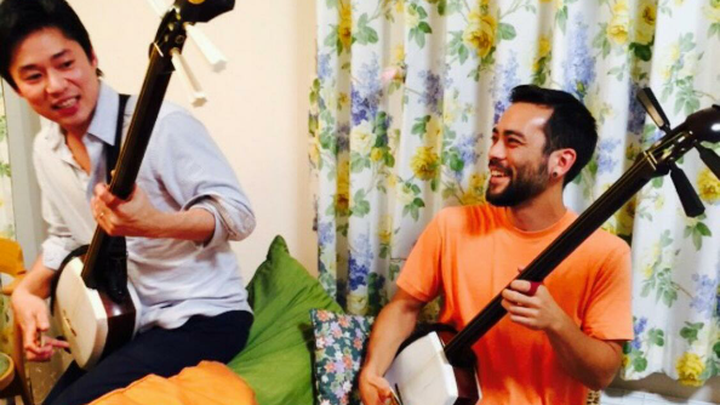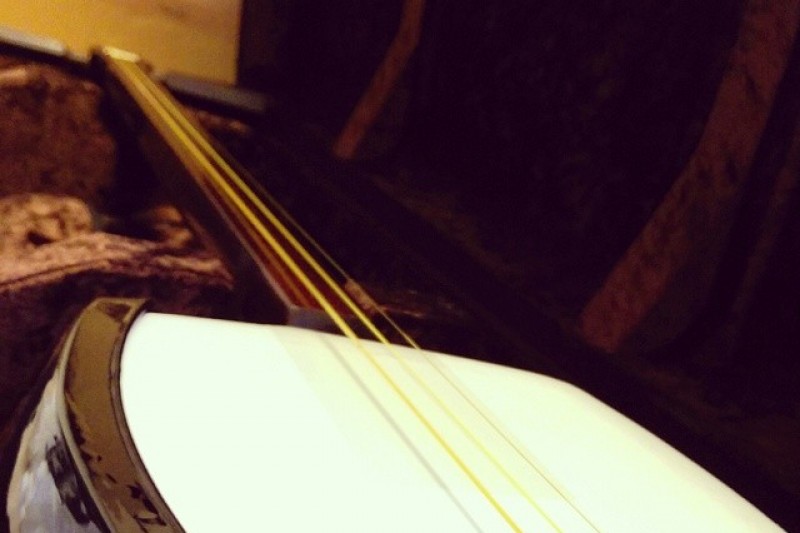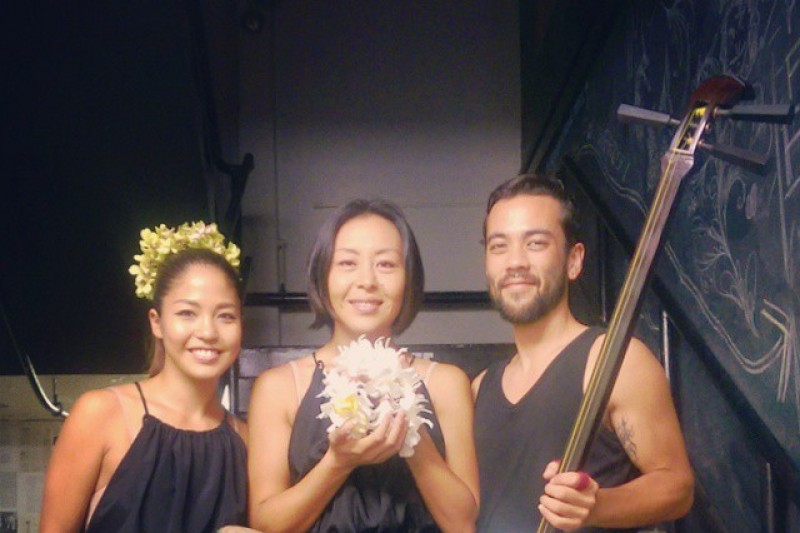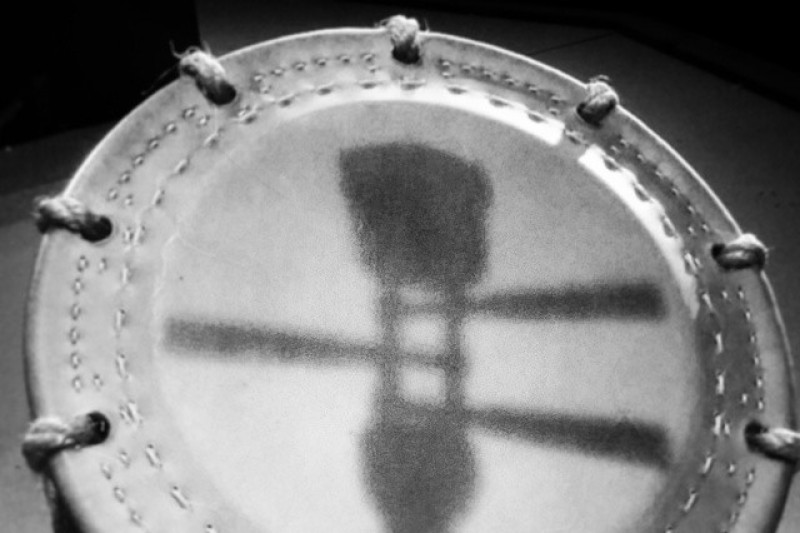
Tsugaru Shamisen Fund
Donation protected
Introduction
Hi there,
My name is patrick but most of you who are reading this probably already know that. I live in Honolulu, Hawai'i and am a barista, musician, taiko player and performer. In March 2015 I will be going to Sapporo, Japan to study an instrument called the "tsugaru shamisen" for one month and I need some help.
TL;DR- please support my gofundme campaign for a tsugaru shamisen
General History
Tsugaru shamisen is a three stringed, fretless, Japanese instrument with a drum body from the northern part of Japan called, Aomori.
It is a derivation of the "sanxian." Originating in China, the sanxian 三弦 traversed through Okinawa where it became the sanshin 三線. Both the sanxian and the sanshin use snake skin for the front and back of the body and are plucked with a pick traditionally made of buffalo horn or the fingers.
"Asadoya Yunta"
You can enjoy so much amazing Okinawan music here in Honolulu during the summer. It is a local custom of the Hawai'ian Islands to bring commuity and family together at temples every weekend throughout the summer months for "obon." If you ever have a chance to visit the islands during the summer, please check them out!
From there, the instrument moved up through Japan and transformed again into what we now know as the shamisen or 三味線, roughly translated as "three tasty line....." Presumably, the change from sanshin to shamisen happened when it came upon musicians of another stringed instrument called the biwa. The biwa player uses a massive plectrum resembling an ice scraper to slap the strings and make a sound resembling thunder and lightning by sliding the plectrum or "bachi" up the neck. Just like Jimmy hendrix and countless rock and metal guitarists since. The biwa is another derivation of the Chinese, Pipa.
The shamisen has two very distinct characteristics attributed to the biwa. First, the sawari or buzzing sound that resonates after a string is hit. Second, the use of a plectrum to strike the strings rather than fingers to pluck. Because of their ingenuity or stubbornness to change, they found the snake skin was too weak and would often rupture from the strikes of the bachi. The result is what you find now in shamisen made in Japan...the skin is either dog or cat (0.0) Sorry animal lovers.
Variations
In general, we now have three variations on the shamisen. In order from smallest to largest they are: nagauta, jiuta and tsugaru.
The "nagauta shamisen" 長唄三味線 is used mainly in the classical form of Japanese music called hogaku that accompanies the kabuki theater. It has the smallest neck of the three and is accompanied by the hogaku hayashi that includes voice, nohkan/shinobue, kotsuzumi, otsuzumi and shime daiko. Nagauta means long song and the pieces have many movements and complicated patterns. In comparison, unlike western orchestration, there is no conductor to lead. The musicians of the hayashi must all "feel" the pulse of the music.
Next is the "jiuta shamisen" 地歌三味線. According to Wikipedia, the jiuta shamisen came into populatiry during the Edo period and was performed by the "todoza" 当道座, a guild of blind men and the "gozeza" 瞽女座, a guild of blind women. They specialized in regional songs commonly refered to as "minyou" 民謡.
Finally, we have what you've all been waiting to read about, the "tsugaru shamisen" 津軽三味線! The tsugaru shamisen is the most recently developed of the three mentioned here and the story goes like this...
There was a boy from the Northern part of Japan in an area called "Aomori." This boy lost his mother and father at a young age. His mother was a musician and father a fisherman. After both parents passed away, the young boy, having lost his sight to sickness, began playing the shamisen. However, he was not allowed to join the "todoza" or the "gozeza." In response, he took to the streets and developed his own style of shamisen playing that was loud, fast and exciting! By necessity of attracting a larger audience amd earning more money, he developed a style of shamisen that we now know today as the tsugaru style.
The Point
Which brings us to the reason you are here and why I am going to Japan. The first time I saw Tsugaru Shamisen was in April of 2012 at the Benaroya Hall in Seattle where I saw the group "Abeya." They were on a special tour through the US and Seattle was a last minute addition.
I was blown away. The speed! The technique! The sound! The soul! After the performance I remember thinking how amazing it would be to play that instrument, but my lack of Japanese language profeciency and access to the shamisen made it seem too unrealistic.

Lo and behold! I now own a tsugaru shamisen of my own and have been so fortunate and grateful to have had many amazing experiences sharing this beautiful instrument with others.
The first time I performed for an audience was at a taiko festival held in Shasta, California called "Shastayama." I came as a taiko player with Kenny Endo's Taiko Ensemble and was given the amazing opportunity to play shamisen on a couple pieces.
An amazing student dancer from the University of Hawai'i's dance department asked me to join her in a collaborative piece featuring live Shamisen and dance.

And thanks to some great people, I got to work with the Honolulu Theater for Youth playing live music for a holiday show of theirs! "Jingle Bells" on shamisen for an audience full of children!!

This year I will be back at theater and hoping to add more shamisen into the taiko ensemble.
I will be traveling to Sapporo this March to study with a sensei there that I was introduced to by a great guy, a soul-sister, named Kyle Abbott. I can say earnestly he is the reason I have had the confidence to get after the shamisen by paving a lot of the road and translating so much valuable information. I mean the guy made his own when he was just a teenager! Check out his online internation shamisen community at bachido.com.
The reason for this crowdfunding campaign is to help me bring back a friend for my current shamisen. Having two shamisen has two awesome benefits.
One, it will allow me to have a backup if something happens to the other. Shamisen skins are sensitive and can rupture very easily. If this happens, the only current way to fix it would be to ship it back to Japan. This can be very expensive and may take up to a month or more. The more I play shamisen, it becomes apparent having a backup is necessary.
Two, brings the potential to introduce others to the tsugaru shamisen. It will open up the opportunity to provide lessons to anyone seeking an introduction without having to invest in their own...because they are expensive and have a few necessary accessories.
Cost Broken Down
Tsugaru Shamisen = $1,000-1,500
Bachi = $250
Koma (bridge) = $30 each
Yubi kake (finger pants) = $10 each
Dou kake (body guard) = $ 40 each
Strings = $ 27 per set
Case = $ 200
Shipping = $ 180
Customs = $ 140
-----------------------------------------------------------------------
Basics Total $2,400
These are just the basics of the costs expeted to purchase a mid-range quality tsugaru shamisen and bring it back to the US. I will also be taking lessons a few times a week and will be searching far and wide for additional stuff such as CD's, DVD's, books etc.
All that this crowd funds will go specifically to bringing back a shamisen to share with others. However, every dollar extra will go directly towards my teacher and any additional resources I come across.
If you are reading this, thank you from the bottom of my heart for making it this far.
Let's play tsugaru shamisen!!
Patrick
Hi there,
My name is patrick but most of you who are reading this probably already know that. I live in Honolulu, Hawai'i and am a barista, musician, taiko player and performer. In March 2015 I will be going to Sapporo, Japan to study an instrument called the "tsugaru shamisen" for one month and I need some help.
TL;DR- please support my gofundme campaign for a tsugaru shamisen
General History
Tsugaru shamisen is a three stringed, fretless, Japanese instrument with a drum body from the northern part of Japan called, Aomori.
It is a derivation of the "sanxian." Originating in China, the sanxian 三弦 traversed through Okinawa where it became the sanshin 三線. Both the sanxian and the sanshin use snake skin for the front and back of the body and are plucked with a pick traditionally made of buffalo horn or the fingers.
"Asadoya Yunta"
You can enjoy so much amazing Okinawan music here in Honolulu during the summer. It is a local custom of the Hawai'ian Islands to bring commuity and family together at temples every weekend throughout the summer months for "obon." If you ever have a chance to visit the islands during the summer, please check them out!
From there, the instrument moved up through Japan and transformed again into what we now know as the shamisen or 三味線, roughly translated as "three tasty line....." Presumably, the change from sanshin to shamisen happened when it came upon musicians of another stringed instrument called the biwa. The biwa player uses a massive plectrum resembling an ice scraper to slap the strings and make a sound resembling thunder and lightning by sliding the plectrum or "bachi" up the neck. Just like Jimmy hendrix and countless rock and metal guitarists since. The biwa is another derivation of the Chinese, Pipa.
The shamisen has two very distinct characteristics attributed to the biwa. First, the sawari or buzzing sound that resonates after a string is hit. Second, the use of a plectrum to strike the strings rather than fingers to pluck. Because of their ingenuity or stubbornness to change, they found the snake skin was too weak and would often rupture from the strikes of the bachi. The result is what you find now in shamisen made in Japan...the skin is either dog or cat (0.0) Sorry animal lovers.
Variations
In general, we now have three variations on the shamisen. In order from smallest to largest they are: nagauta, jiuta and tsugaru.
The "nagauta shamisen" 長唄三味線 is used mainly in the classical form of Japanese music called hogaku that accompanies the kabuki theater. It has the smallest neck of the three and is accompanied by the hogaku hayashi that includes voice, nohkan/shinobue, kotsuzumi, otsuzumi and shime daiko. Nagauta means long song and the pieces have many movements and complicated patterns. In comparison, unlike western orchestration, there is no conductor to lead. The musicians of the hayashi must all "feel" the pulse of the music.
Next is the "jiuta shamisen" 地歌三味線. According to Wikipedia, the jiuta shamisen came into populatiry during the Edo period and was performed by the "todoza" 当道座, a guild of blind men and the "gozeza" 瞽女座, a guild of blind women. They specialized in regional songs commonly refered to as "minyou" 民謡.
Finally, we have what you've all been waiting to read about, the "tsugaru shamisen" 津軽三味線! The tsugaru shamisen is the most recently developed of the three mentioned here and the story goes like this...
There was a boy from the Northern part of Japan in an area called "Aomori." This boy lost his mother and father at a young age. His mother was a musician and father a fisherman. After both parents passed away, the young boy, having lost his sight to sickness, began playing the shamisen. However, he was not allowed to join the "todoza" or the "gozeza." In response, he took to the streets and developed his own style of shamisen playing that was loud, fast and exciting! By necessity of attracting a larger audience amd earning more money, he developed a style of shamisen that we now know today as the tsugaru style.
The Point
Which brings us to the reason you are here and why I am going to Japan. The first time I saw Tsugaru Shamisen was in April of 2012 at the Benaroya Hall in Seattle where I saw the group "Abeya." They were on a special tour through the US and Seattle was a last minute addition.
I was blown away. The speed! The technique! The sound! The soul! After the performance I remember thinking how amazing it would be to play that instrument, but my lack of Japanese language profeciency and access to the shamisen made it seem too unrealistic.

Lo and behold! I now own a tsugaru shamisen of my own and have been so fortunate and grateful to have had many amazing experiences sharing this beautiful instrument with others.
The first time I performed for an audience was at a taiko festival held in Shasta, California called "Shastayama." I came as a taiko player with Kenny Endo's Taiko Ensemble and was given the amazing opportunity to play shamisen on a couple pieces.
An amazing student dancer from the University of Hawai'i's dance department asked me to join her in a collaborative piece featuring live Shamisen and dance.

And thanks to some great people, I got to work with the Honolulu Theater for Youth playing live music for a holiday show of theirs! "Jingle Bells" on shamisen for an audience full of children!!

This year I will be back at theater and hoping to add more shamisen into the taiko ensemble.
I will be traveling to Sapporo this March to study with a sensei there that I was introduced to by a great guy, a soul-sister, named Kyle Abbott. I can say earnestly he is the reason I have had the confidence to get after the shamisen by paving a lot of the road and translating so much valuable information. I mean the guy made his own when he was just a teenager! Check out his online internation shamisen community at bachido.com.
The reason for this crowdfunding campaign is to help me bring back a friend for my current shamisen. Having two shamisen has two awesome benefits.
One, it will allow me to have a backup if something happens to the other. Shamisen skins are sensitive and can rupture very easily. If this happens, the only current way to fix it would be to ship it back to Japan. This can be very expensive and may take up to a month or more. The more I play shamisen, it becomes apparent having a backup is necessary.
Two, brings the potential to introduce others to the tsugaru shamisen. It will open up the opportunity to provide lessons to anyone seeking an introduction without having to invest in their own...because they are expensive and have a few necessary accessories.
Cost Broken Down
Tsugaru Shamisen = $1,000-1,500
Bachi = $250
Koma (bridge) = $30 each
Yubi kake (finger pants) = $10 each
Dou kake (body guard) = $ 40 each
Strings = $ 27 per set
Case = $ 200
Shipping = $ 180
Customs = $ 140
-----------------------------------------------------------------------
Basics Total $2,400
These are just the basics of the costs expeted to purchase a mid-range quality tsugaru shamisen and bring it back to the US. I will also be taking lessons a few times a week and will be searching far and wide for additional stuff such as CD's, DVD's, books etc.
All that this crowd funds will go specifically to bringing back a shamisen to share with others. However, every dollar extra will go directly towards my teacher and any additional resources I come across.
If you are reading this, thank you from the bottom of my heart for making it this far.
Let's play tsugaru shamisen!!
Patrick
Organizer
Patrick Oiye
Organizer
Honolulu, HI


